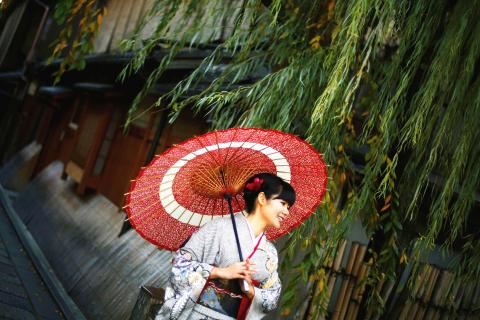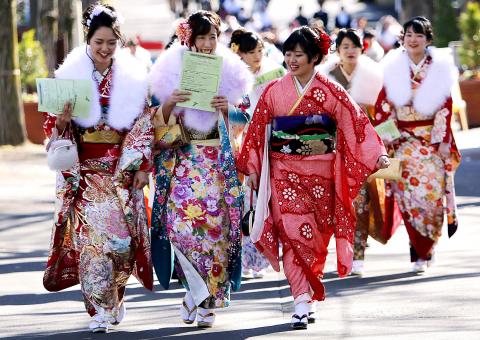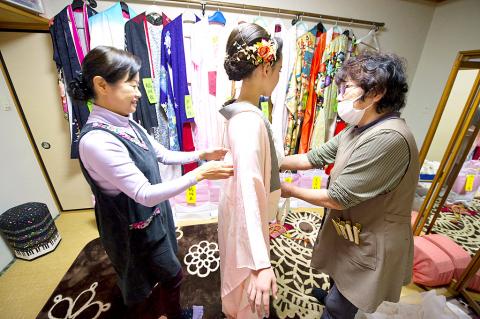Kazuhiko Kanai uses the traditional method to dye the elegant kimonos for which this small, semitropical island is renowned: He carries a bundle of pure white silk to a nearby rice paddy and hurls it into the mud.
Kanai is one of the last practitioners of a method known as dorozome, or “mud-dyeing,” which uses the island’s iron-rich soil to turn silk the color of the darkest chocolate. This is just one step in an elaborate production process that can take a year to produce a kimono with the glossiest silk and most intricately woven designs in all Japan. In a nation that esteems its traditional form of dress as high art, Amami Oshima’s kimonos became some of the most prized of them all, once capable of fetching more than US$10,000 apiece.
But those heady days are over, as a shift to Western fashions and Japan’s long economic squeeze have led to plummeting demand, especially for high-end kimonos.

Photo: Reuters
On Amami Oshima, production has fallen so far in the last two decades that only 500 people on an island with 73,000 residents remain employed full-time in kimono production, and many of them are in their 70s or 80s. That’s down from 20,000 people a generation ago, according to the Authentic Amami Oshima Tsumugi Association, the island’s union of kimono producers.
The union says the island’s production of kimono silk has similarly plunged, from enough to make 284,278 kimonos during the height of the postwar boom in 1972, to enough for just 5,340 kimonos last year.
ANTIQUATED SYSTEM

Photo: Reuters
Amami Oshima has fallen harder than most of Japan’s famous kimono production centers, dragged down by a complex web of wholesalers, dealers and specialized retailers who distribute and sell the island’s kimonos. While this antiquated system once benefited the remote southern island near Okinawa by spreading its kimonos to the rest of Japan, islanders say it has now become a burden, keeping the kimonos prohibitively expensive while driving down wages.
Yet, the old ways have proved hard to discard, despite a growing sense of crisis. Many fret that there will soon be too few islanders left with the skills to sustain each of the 30 separate steps needed to produce one of the kimonos.
“If we lose one link in the chain, we lose our ability to make kimonos,” said Kanai, 56, who owns a dirt-floored wooden workshop where silk is dyed in bubbling iron caldrons and then hung from the ceiling to dry. “If we cannot make kimonos any more, what will be left here?”

Photo: EPA
COMPLICATED PROCESS
Kanai says the mud-dyeing process alone takes more than a month, as the silk is first colored a burgundy hue with natural dye made from the pulp of a local plum tree. Getting the right shade of red requires repeating the cycle of staining and drying the silk 30 times, he said. Only then is the silk ready to be immersed in the black mud, whose iron reacts with tannins in the tree dye to create the coveted dark brown color.
That is not the most elaborate step. Even before the silk arrives at Kanai’s workshop, it is first woven into a temporary fabric as part of a unique method that the islanders have devised for creating minutely detailed patterns.
After this temporary fabric has been mud-dyed, it is unraveled back into its original silk threads. Each colored thread now has thousands of tiny white stripes where it overlapped with another thread, blocking the mud from touching it at that point.
As the threads are rewoven into new fabric by nimble-fingered island women, they slowly reveal perfectly formed patterns, ranging from starkly minimalist shapes to elaborate scenes of bamboo groves and flying storks.
“The weaver has a tremendous responsibility,” said Mifuko Iwasaki, 70, who has been teaching young islanders how to weave these perfectly aligned patterns on hand looms for 35 years. “If we make a mistake, we undo all the hard work of those who spent so much timing preparing this thread.”
Iwasaki says that when she began teaching her yearlong classes, she typically had 40 students, who were drawn by the fact that weaving offered higher wages than fishing, farming and logging, the island’s other industries at the time.
These days, she says she is lucky to get more than two or three students, because weaving no longer pays as well. The myriad middlemen in the cumbersome distribution system each take a cut, making it hard to reduce prices at the same rate as other items in deflationary Japan. Worse, the brunt of what price cuts have been made inevitably falls on the island’s dyers and weavers. As a result, while a new Oshima kimono can still cost US$3,000 to US$6,000 in Tokyo, weavers say they are lucky to get more than US$400 for a month’s exacting work. Other craftsmen in the production process get even less.
ECONOMIC MICROCOSM
Nonetheless, islanders say they are reluctant to bypass the antiquated distribution system, saying they feel bound by generations-old obligations and a fear of change. This makes them a microcosm of Japan as a whole, which has been slow to give up its outdated postwar economic model despite years of stagnation.
“It is ironic that we can no longer make ends meet producing something so expensive,” said Shigehiko Furuta, 67, who uses colored pens and graph paper to design the minutely detailed patterns.
Shinichiro Yamada, 83, the head of the producers’ union, said the island’s ornately woven patterns have their roots in the colorful culture of the Kingdom of the Ryukyus, centered in current-day Okinawa. They ruled Amami Oshima until the early 17th century, when the island was conquered by Japanese samurai, who claimed the island’s kimonos as tribute.
Mud-dyeing started when disobedient islanders buried kimonos in the ground to hide them, only to discover on digging them up again that the fabrics had turned a beautiful dark color, said Kanai, who owns the mud-dyeing workshop.
His son, Yukihito, now uses those same centuries-old dyeing techniques to color new types of items, including T-shirts, jeans and even guitar bodies. He is experimenting with selling these over the Internet, to avoid the onerous distribution system.
“We need to become more like artisans in Europe or artists in New York,” said the younger Kanai, 35, who said he is one of the few “young successors” in the island’s kimono industry. “Even traditions have to evolve.”

On April 26, The Lancet published a letter from two doctors at Taichung-based China Medical University Hospital (CMUH) warning that “Taiwan’s Health Care System is on the Brink of Collapse.” The authors said that “Years of policy inaction and mismanagement of resources have led to the National Health Insurance system operating under unsustainable conditions.” The pushback was immediate. Errors in the paper were quickly identified and publicized, to discredit the authors (the hospital apologized). CNA reported that CMUH said the letter described Taiwan in 2021 as having 62 nurses per 10,000 people, when the correct number was 78 nurses per 10,000

As we live longer, our risk of cognitive impairment is increasing. How can we delay the onset of symptoms? Do we have to give up every indulgence or can small changes make a difference? We asked neurologists for tips on how to keep our brains healthy for life. TAKE CARE OF YOUR HEALTH “All of the sensible things that apply to bodily health apply to brain health,” says Suzanne O’Sullivan, a consultant in neurology at the National Hospital for Neurology and Neurosurgery in London, and the author of The Age of Diagnosis. “When you’re 20, you can get away with absolute

May 5 to May 11 What started out as friction between Taiwanese students at Taichung First High School and a Japanese head cook escalated dramatically over the first two weeks of May 1927. It began on April 30 when the cook’s wife knew that lotus starch used in that night’s dinner had rat feces in it, but failed to inform staff until the meal was already prepared. The students believed that her silence was intentional, and filed a complaint. The school’s Japanese administrators sided with the cook’s family, dismissing the students as troublemakers and clamping down on their freedoms — with

As Donald Trump’s executive order in March led to the shuttering of Voice of America (VOA) — the global broadcaster whose roots date back to the fight against Nazi propaganda — he quickly attracted support from figures not used to aligning themselves with any US administration. Trump had ordered the US Agency for Global Media, the federal agency that funds VOA and other groups promoting independent journalism overseas, to be “eliminated to the maximum extent consistent with applicable law.” The decision suddenly halted programming in 49 languages to more than 425 million people. In Moscow, Margarita Simonyan, the hardline editor-in-chief of the